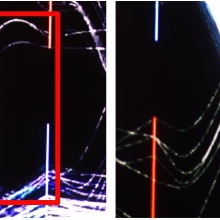VIS/US researchers Florian Frieß, Matthias Braun, Valentin Bruder, Steffen Frey, Guido Reina, and Thomas Ertl received the Best Paper Award at the 10th IEEE Symposium on Large Data Analysis and Visualization (LDAV).
In their awarded publication "Foveated Encoding for Large High-Resolution Displays" they present a system that dynamically adapts the encoding quality in a way that reduces the required bandwidth without impacting the details perceived by one or more observers on large displays. This system can be useful for collaborative exploration of scientific data sets across large high-resolution display.
Their system is based on the tracking of the observers' gaze, which allows to identify areas of the image that are important for the observers. The image quality needs to be high in these regions, while the quality of surrounding areas can be lowered with barely noticeable changes in visual quality. This leads to a reduction in the required bandwidth, which is crucial for collaborative analysis across display walls with big data sets.
About LDAV
The 10th IEEE Symposium on Large Data Analysis and Visualization (LDAV) was held virtual on October 25, 2020. It "brings together domain scientists, data analysts, visualization researchers, and users to foster common ground for solving both near- and long-term problems. [...] Topic emphasis is on algorithms, languages, systems, and/or hardware solutions that support the collection, analysis, manipulation, or visualization of large-scale data." (www.ldav.org/2020)
LDAV was held in conjuction with the virtual IEEE Visualization Conference (VIS).
14 Contributions from VIS/US for 2020 IEEE VIS
The IEEE VIS is one of the top venues for visualization research worldwide. This year 14 papers from VIS/US researchers were accepted:
- Foveated Encoding for Large High-Resolution Displays (LDAV Best Paper - Florian Friess, Matthias Braun, Valentin Bruder, Steffen Frey, Guido Reina, and Thomas Ertl)
- PlotThread: Creating Expressive Storyline Visualizations using Reinforcement Learning (Johannes Knittel, Andres Lalama, Steffen Koch, Thomas Ertl)
- Visual Neural Decomposition to Explain Multivariate Data Sets (Johannes Knittel, Steffen Koch, Thomas Ertl)
- Spatial Partitioning Strategies for Memory-Efficient Ray Tracing of Particles (Patrick Gralka, Sergej Geringer, Guido Reina, Thomas Ertl)
- Interpretable Visualizations of Deep Neural Networks for Domain Generation Algorithm Detection (Franziska Becker, Christoph Müller, Thomas Ertl)
- Visual Causality Analysis of Event Sequence Data (Daniel Weiskopf)
- Data-Driven Space-Filling Curves (Daniel Weiskopf)
- Implicit Multidimensional Projection of Local Subspaces (Daniel Weiskopf)
- What We See and What We Get from Visualization: Eye Tracking Beyond Gaze Distributions and Scanpaths (Michael Burch, Daniel Weiskopf)
- Pipelines Bent, Pipelines Broken: Interdisciplinary Self-Reflection on the Impact of COVID-19 on Current and Future Research (Katrin Angerbauer, Cristina Morariu, Daniel Weiskopf, Michael Sedlmair)
- Palettailor: Discriminable Colorization for Categorical Data (Michael Sedlmair)
- Revisited: Comparison of Empirical Methods to Evaluate Visualizations Supporting Crafting and Assembly Purposes (Maximilian Weiß, Katrin Angerbauer, Magdalena Schwarzl, Michael Sedlmair)
- DRUIDJS - A JavaScript Library for Dimensionality Reduction (Rene Cutura, Michael Sedlmair)
- SineStream: Improving the Readability of Streamgraphs by Minimizing Sine Illusion Effects (Michael Sedlmair)
| Contact | Leon Kokkoliadis (leon.kokkoliadis@visus.uni-stuttgart.de) |
|---|



